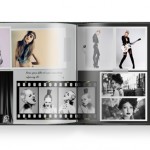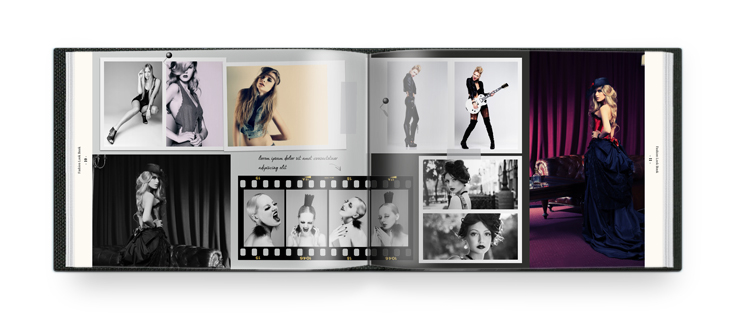

Fashion Look Book | by Photobook Worldwide
In this era of digital and Internet wonders, perhaps a fair enough question to ask is this: Why would anyone need to print a portfolio of their work?
It’s understandable, as they can just upload their best work onto their website or create a Flash animation of their photos on their computer. They can then go ahead and ask their prospective clients to go online and refer to them or whip out their iPad during a meeting or proposal. It’s more convenient than carrying around a relatively bulky portfolio, one might consider.
The answer to the question, as some have attested, is this: Having your portfolio in print suggests a sense of seriousness that is not as pronounced in one’s online or digital portfolio. A printed portfolio tends to show greater professionalism, as implied by the conscientious additional work and cost put into having your work printed with the best paper and bound with quality materials, as well as the effort, of course, in carrying it to meetings or presentations. Also, nothing compares to holding a fine piece of workmanship in your hands. Portfolios need not be limited to only Photographers, in fact portfolios are a must for Fashion Designers, Interior Decorators, Wedding Planners, Architects, Illustrators, Artists and can even as a professional resume!
Tips on creating your own printed portfolio :-
Identify your audience & target demographic
Your portfolio needs to reflect the relationship you want to build with your target audience, whether it is a couple looking for a wedding shoot or an agency looking for a commercial shoot or even a potential employer you want to impress. A portfolio that gives the wrong image will not attract the clients you want, or land you the job you have been eyeing. To better understand the target audience, ask yourself the following questions :-
- Which images do I want to show my audience?
- Which images I do not want to show my audience?
- Is my work intended for a single audience or multiple audiences?
- What response do I want from the audience? To please, to surprise, to challenge, to shock etc.
Identify the goal and purpose
This goes hand in hand with the first tip. Portfolios are created for a variety of reasons and depending on what is it for, the portfolio look & feel can differ from one another. Here are a couple of examples that portfolios are created for :-
- Used to showcase products at an event or trade show
- Presentation centrepiece for client
- Graphical and chronological portfolio used as a resume
- Proposal for business opportunities or a job
- Submission for an award
- Multi purpose usage – as a coffee table book
A portfolio is also perfect to see what you’ve accomplished so far and where you are heading. Creating a collection of such portfolios is like documenting your photography journey and would make great coffee table books.
Content of Your Portfolio
Your portfolio is an opportunity to express yourself in ways other than your photographs. The photographs are only part of the total content of a portfolio. Write and talk about what you do, explain why and how your images are created. Below is a short list on what you can include in your portfolio :-
- An artist statement
- A title list of the photographs included in the portfolio (similar to a Content Page)
- A cover image representative of the portfolio as a whole
- Thumbnails of each photograph
- A packaging box for your portfolio – we suggest slipcases or clamshell-style presentation boxes
While there is no single rule about what to include in your portfolio, your content should be aligned to your goal and purpose of the portfolio.
Decide which photos to include
This would probably be the hardest part of making the portfolio – deciding which photos to include and what not to include. Here are a few tips on selecting photographs for your portfolio :-
- Start by deciding how many photos you want to include in your portfolio. Too little and too many is an absolute issue. As a benchmark, first decide on how many pages your portfolio will be and then have a simple draft of how many images you want to include in a single page and the layout of the portfolio.
- Make your selection progressively. Start with 100, then narrow it down to 50 and then to your desired quantity. Allow yourself time in between to think and re-select where required.
- Obtain feedback. It is said that a photographer is not the best judge of his work as he or she may take into consideration their post-processing efforts in appraising the work. Given this, it is best that you ask another person with an eye for photography to help you decide which photographs will make it to your portfolio and for a second opinion.
Don’t settle for second best
After considering the above mentioned points, you then wrap up your portfolio, figuratively and literally, and proceed to choose a photobook type that suits your purpose and goal. At Photobook Worldwide, you can choose from an Imagewrap Hardcover, Debossed Hardcover, Professional Series or if you want, maybe a Softcover version. Select the paper type to suit your preference – depending on the type of photobook you’ve selected (some photobooks may offer different default paper) you can choose from either Premium Silk 170gm, Premium Silk 216gm, Matte Textured 170gm, Superfine Eggshell 150gm or Photo Lustre 190gm. And, if you need a little help in designing your printed portfolio or maybe just need some inspiration, check out the below portfolio-inspired Readybooks :-
Catalogue Readybook
About the Readybook: Impress prospective clients with the Catalogue Readybook. Its captivating layout highlights the strengths, design and practicality of your products, which leads to a positive impression on your customers.
Fashion Lookbook Readybook
About the Readybook: Style matters most to fashion lovers, and that manifests in everything related to their passion. The Fashion Look Readybook adds a premium touch to the value of style and taste, as shown in its minimalist yet striking layout. It highlights the designs featured, as well as the impeccable eye of the photographer behind the photos.
To summarize, the 5 tips to creating a print portfolio are:
- Identify the audience and target demographic
- Identify the goal and purpose
- Content of the Portfolio
- Deciding on which Photos to use
- Don’t settle for second best
We hope you have a great time making your printed portfolio!
SUBSCRIBE to us now and get a FREE 6" x 6" Mini Softcover Photobook (40 pages) or 4R Prints (100 Pcs)!
If you require further assistance, please contact our Support Team at support[at]photobookworldwide.com (Please replace the [at] with @)





